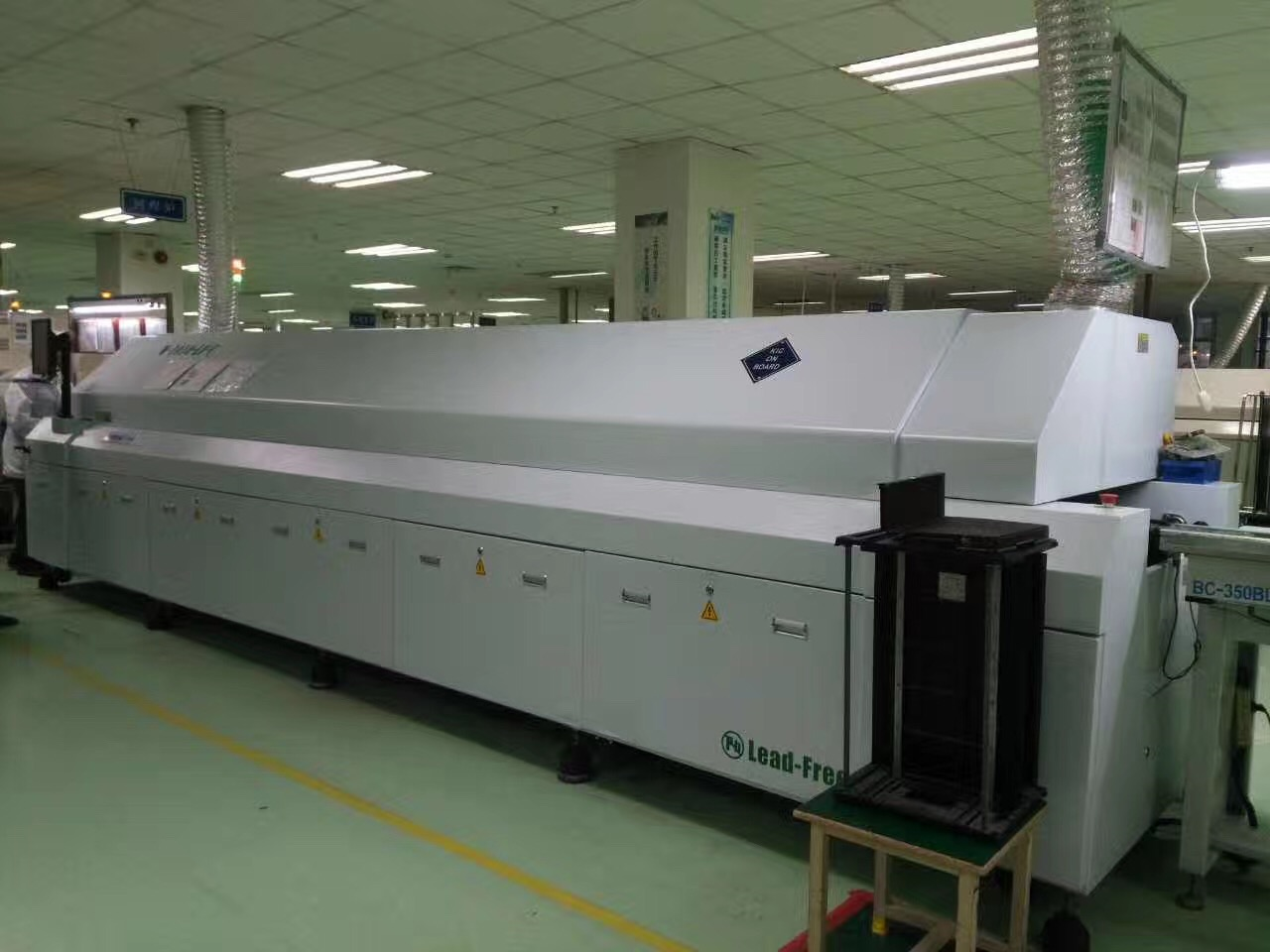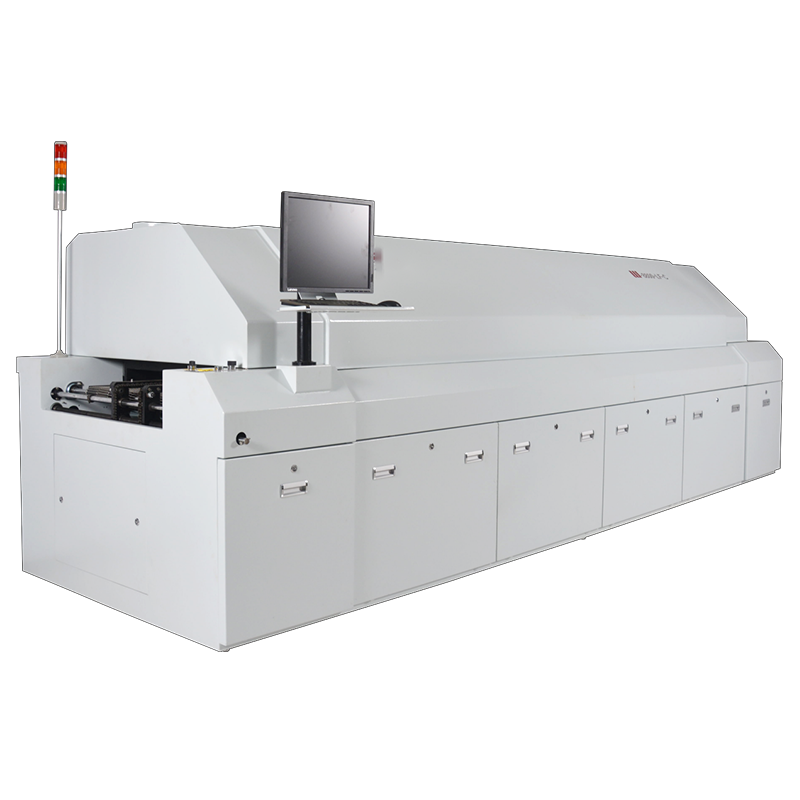Error de formato de correo electrónico
emailCannotEmpty
emailDoesExist
pwdLetterLimtTip
inconsistentPwd
pwdLetterLimtTip
inconsistentPwd


Lead Free Reflow Oven Factory Supplier
A lead-free reflow oven is a crucial piece of equipment used in the surface mount technology (SMT) assembly process for electronic circuit boards, particularly in compliance with regulations such as the Restriction of Hazardous Substances (RoHS) directive. Here's an overview of what it is and how it works:
-
Purpose:
- Lead-free reflow ovens are designed to solder surface mount components onto PCBs using lead-free solder paste. Lead-free soldering is essential for compliance with environmental regulations and ensuring the safety of electronic products.
-
Operation:
- The reflow process involves several stages: preheat, soak, reflow, and cooling.
- PCBs with solder paste applied to their pads are transported through the reflow oven on a conveyor belt.
- In the preheat zone, the PCBs are gradually heated to activate the flux in the solder paste and remove moisture.
- The soak zone maintains the PCBs at a specific temperature for a set period to ensure uniform heating and prevent thermal shock to components.
- In the reflow zone, the temperature is raised above the melting point of the solder paste, causing it to liquefy and form solder joints between the components and PCB pads.
- Finally, in the cooling zone, the PCBs are rapidly cooled to solidify the solder joints and prevent component damage.
-
Features:
- Lead-free reflow ovens are equipped with precise temperature control systems to ensure uniform heating and prevent overheating or underheating of PCBs.
- They may have multiple heating zones (typically three to six) with individual temperature profiles to accommodate different solder paste types and PCB designs.
- Conveyor speed can be adjusted to control the dwell time of PCBs in each heating zone and optimize the reflow process.
- Some advanced reflow ovens feature nitrogen inerting systems to reduce oxidation and improve solder joint quality, particularly for lead-free soldering.
-
Benefits:
- Compliance: Lead-free reflow ovens enable manufacturers to comply with environmental regulations such as RoHS, which restrict the use of hazardous substances like lead in electronic products.
- Quality: Properly controlled reflow processes result in high-quality solder joints with good wetting and reliability, ensuring the performance and longevity of electronic assemblies.
- Efficiency: Automated reflow ovens streamline the SMT assembly process, increasing throughput and reducing labor costs compared to manual soldering methods.

A lead-free reflow oven is a crucial component in the surface mount technology (SMT) assembly process, specifically designed to solder electronic components onto printed circuit boards (PCBs) without the use of lead-based solder. Lead-free soldering is essential for compliance with environmental regulations and ensures the safety of electronic products.
Key Features:
-
Temperature Control: Lead-free solder typically requires higher reflow temperatures compared to traditional lead-based solder. The reflow oven should offer precise temperature control to achieve the required soldering temperatures without damaging sensitive components or PCBs.
-
Conveyor System: A conveyor system transports PCBs through the reflow oven at a controlled speed, ensuring consistent heating and cooling cycles for uniform soldering results.
-
Heating Zones: Reflow ovens typically consist of multiple heating zones, each with its heating elements and temperature controls. These zones allow for precise temperature profiles tailored to the specific requirements of lead-free soldering.
-
Cooling Zone: Following the reflow process, a cooling zone rapidly cools the soldered PCBs to prevent component damage and ensure solder joint integrity.
-
Flux Management: Lead-free soldering often requires the use of flux to promote solder wetting and improve solder joint quality. Some reflow ovens feature flux management systems to apply flux evenly onto the PCBs before the soldering process.
-
Nitrogen Atmosphere: In some cases, a nitrogen atmosphere may be used in the reflow oven to minimize oxidation and improve solder joint quality, particularly for sensitive components or high-reliability applications.
-
Profile Management: Reflow ovens may offer profile management capabilities, allowing operators to store and recall temperature profiles optimized for different PCB designs and soldering requirements.
Benefits:
-
Compliance: Lead-free reflow ovens enable manufacturers to comply with environmental regulations, such as the Restriction of Hazardous Substances (RoHS) directive, which restricts the use of lead in electronic products.
-
Improved Reliability: Lead-free soldering can result in solder joints with improved mechanical strength and reliability, enhancing the overall quality and longevity of electronic assemblies.
-
Environmental Sustainability: Lead-free soldering reduces the environmental impact associated with lead contamination and hazardous waste disposal, supporting sustainable manufacturing practices.
-
Global Market Access: Products manufactured using lead-free processes are more easily accepted in international markets with stringent regulatory requirements for environmental protection.
Considerations:
-
Temperature Uniformity: Ensure the reflow oven provides uniform heating across the PCB surface and between different heating zones to prevent uneven soldering and component damage.
-
Compatibility: Verify that the reflow oven is compatible with the specific lead-free solder alloys and flux formulations used in your assembly process.
-
Throughput: Consider the oven's throughput capabilities to meet production volume requirements efficiently.
-
Maintenance and Support: Choose a reflow oven from a reputable manufacturer with reliable maintenance and support services to minimize downtime and ensure long-term operation.
How To Find A Lead Free Reflow Oven Factory Supplier
Finding a lead-free reflow oven factory supplier involves a combination of research, evaluation, and communication. Here's a step-by-step guide to help you find the right supplier:
1. Define Your Requirements:
- Determine your specific needs regarding the type, specifications, and quantity of lead-free reflow ovens you require.
- Consider factors such as oven size, conveyor width, number of heating zones, control system, production capacity, and budget.
2. Research Online:
- Utilize search engines, industry-specific directories, and online marketplaces to find potential suppliers of lead-free reflow ovens.
- Look for manufacturers or suppliers with a proven track record in producing high-quality reflow ovens and catering to the electronics manufacturing industry.
3. Attend Trade Shows and Exhibitions:
- Attend industry trade shows, exhibitions, and conferences related to electronics manufacturing equipment.
- These events provide opportunities to meet multiple suppliers, see product demonstrations, and establish connections within the industry.
4. Check Industry Associations and Publications:
- Explore industry associations, forums, and publications related to electronics manufacturing, surface mount technology (SMT), or printed circuit board (PCB) assembly.
- These resources often feature directories of reputable suppliers and valuable insights into the latest trends and technologies in the industry.
5. Evaluate Supplier Capabilities:
- Review the websites, product catalogs, and customer testimonials of potential suppliers to assess their capabilities, product range, and reputation.
- Look for suppliers that offer lead-free reflow ovens meeting international standards and certifications such as CE, UL, or RoHS compliance.
6. Contact Suppliers:
- Reach out to selected suppliers via email, phone, or online inquiry forms to express your interest and request additional information.
- Provide details about your requirements and ask relevant questions regarding product specifications, customization options, pricing, lead times, and after-sales support.
7. Request Samples or Demonstrations:
- If feasible, request samples of lead-free reflow ovens or arrange product demonstrations to evaluate their performance, features, and build quality.
- Assess the ease of operation, temperature uniformity, heating efficiency, and any additional features offered by the supplier.
8. Conduct Due Diligence:
- Verify the supplier's credentials, manufacturing facilities, quality control processes, and compliance with industry regulations.
- Request references from past clients or visit their manufacturing facilities to gain insights into their production capabilities and quality standards.
9. Negotiate and Finalize Terms:
- Negotiate pricing, payment terms, delivery schedules, and any customization requirements with the selected supplier.
- Review and finalize contractual agreements, including warranties, service agreements, and intellectual property rights.
10. Establish Long-Term Relationship:
- Maintain open communication with the supplier and establish a collaborative relationship based on trust, transparency, and mutual respect.
- Regularly assess the supplier's performance and provide feedback to ensure continuous improvement and satisfaction.
By following these steps and conducting thorough research and evaluation, you can find a reliable lead-free reflow oven factory supplier that meets your specific needs and requirements.

